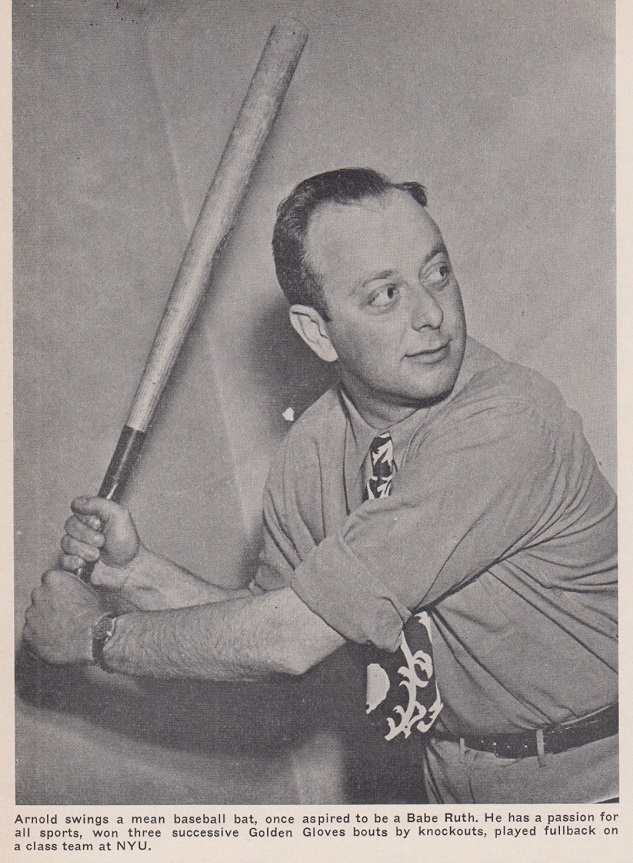
Edward Winter

Arnold Denker, Chess Review, August-September 1944, page 16
From an article by Capablanca, ‘How I Learned to Play Chess’, on pages 94-96 of Munsey’s Magazine, October 1916:
‘As a matter of fact, I cherish as one of my special accomplishments my more than ordinary ability in that very mundane but good American game of baseball. Such a thing, surely, must be foreign to genius!’
As reported on page 71 of our book on the Cuban, the November 1913 American Chess Bulletin, page 71, quoted comments he made to the magazine:
‘I am afraid that I shall miss my baseball and tennis while in Russia, but I shall try to become proficient in some other outdoor sports like horseback riding, etc. Or I may take up fencing and gymnasium work. I thoroughly believe in keeping in good trim physically.’
On page 20 we wrote:
‘... La Discusión (23 August [1909], page 8) reported on another speciality of Capablanca’s; in an Amateur Baseball Championship match between teams from Vedado and Marianao “Capablanca at shortstop made two splendid catches”. Later, when he was up at bat, the umpire had just called one strike against him when rain stopped play.’
The photograph below was on page 209 of Chess Facts and Fables, from C.N.s 3250 and 3258, and appeared, in larger format, in C.N. 5108:
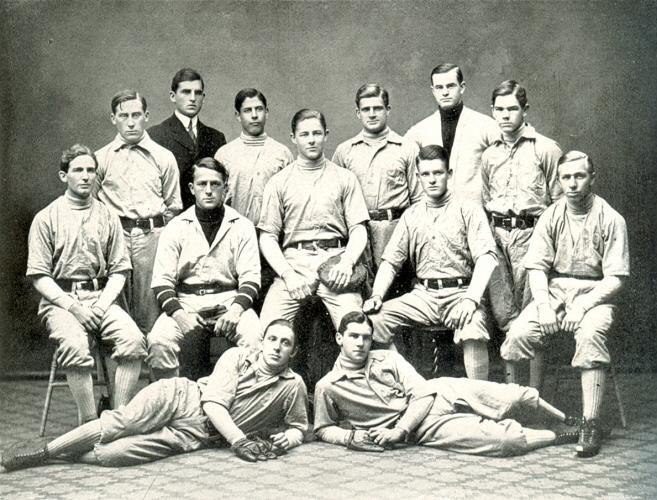
Source: The Columbian 1909, page 140. Capablanca is standing third from the left:
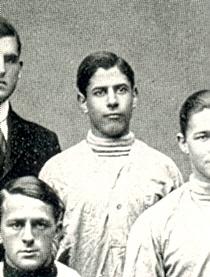
A further photograph of Capablanca is reproduced here, with the permission of the editor, Frank Brady (New York, NY, USA), from page 20 of Chessworld, May-June 1964:
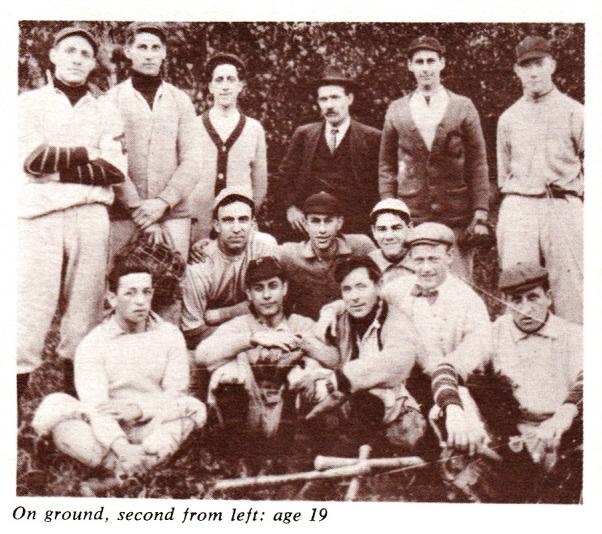
Jerry Spinrad (Nashville, TN, USA) informs us that he is researching the baseball career of Jackson Showalter and is seeking, in particular, substantiation of the widely-published claim that Showalter invented the curve ball. Information about any early occurrences of that claim will be appreciated.
We note that it was mentioned, sourcelessly, by A. Soltis on page 30 of the April 1980 Chess Life. On the general subject of Showalter and baseball we can give a couple of quotes from pages 242-245 of the June 1892 BCM:
‘... he received a first-class school and college education – which included baseball.’
‘His tendency is the national game of baseball – in England he would have been a cricketer with a good strain of football thrown in. He travelled with the Georgetown baseball team, of which he was the only amateur, in a successful Southern tour some years ago, encountering all the crack teams from the Ohio River to the Gulf, New Orleans included. ... He is a baseball crank.’
(4449)
W.D. Rubinstein (Aberystwyth, Wales) writes:
‘In baseball, the pitcher attempts to get the batter to strike out by throwing a variety of tricky pitches. One of the oldest is the “curveball”, in which the pitcher puts a spin on the baseball such that it appears to curve away from the batter and then back towards him as it travels from the pitcher’s throwing arm to home plate.
The curveball has been a part of baseball since the 1860s or early 1870s and is generally regarded as having been invented around 1867 by William “Candy” Cummings, although there are several other claimants. The first recorded use of the term “curveball” is in the New York Herald on 7 July 1874 according to page 118 of The Dickson Baseball Dictionary by Paul Dickson (New York, 1989).
It seems clear that Jackson Showalter, who was born in 1860, could not have invented the curveball.’
[Regarding Showalter’s year of birth, see C.N. 6972 below.]
(4456)
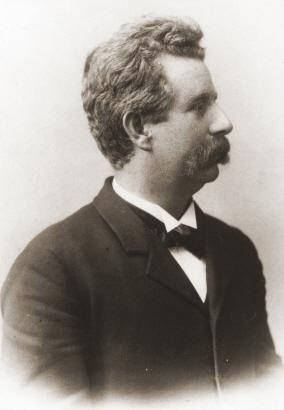
Jackson Whipps Showalter
We now note the following reference in Showalter’s obituary on page 63 of the March 1935 Chess Review:
‘Mr Showalter was famous as a baseball player and was an ardent fan up until the latter part of his life, when bad health kept him at home. He was the first man in Kentucky to pitch a curve ball and one of the seven men who discovered the curve.’
(5700)
Several C.N. items have discussed Jackson Whipps Showalter’s alleged connection with baseball, and in C.N. 5706 Kevin Marchese reported that he was writing a book which would demonstrate that the master’s date of birth was 5 February 1859 (and not 5 February 1860, as commonly believed).
Larry Crawford (Milford, CT, USA) takes up both matters:
‘It appears that Mr Marchese is correct that Showalter was born in 1859. A photograph of his plaque in the Georgetown cemetery reads “1859-1935”. Another webpage says that Showalter was born on 5 February 1859 in Minvera, Bracken Co, KY, the information being taken from the “Kentucky Birth Records 1852-1910”. Furthermore, it is stated that the death records covering the period 1852-1953 gave 1860, which suggests that they may be the source of the error.
As regards claims that Showalter invented the curve ball in baseball, William Arthur “Candy” Cummings is widely accepted by baseball experts as the inventor. His Baseball Hall of Fame plaque lists 1867 as the year of the invention, but Cummings maintained that he thought of the idea as early as 1863 and practiced his delivery for years, which put him ahead of other pitchers of the era. His description below is from a reprint of his article in the September 1908 issue of Baseball Magazine (“How I Pitched the First Curve Ball”) on page 33 of The Neyer/James Guide to Pitchers by R. Neyer and B. James (New York, 2004):
“In 1867 I, with the [Brooklyn] Excelsior club, went to Boston, where we played the Lowells, the Tri-Mountains, and Harvard clubs. During these games I kept trying to make the ball curve. It was during the Harvard game that I became fully convinced that I had succeeded in doing what all these years I had been striving to do. The batters were missing a lot of balls; I began to watch the flight of the ball through the air, and I distinctly saw it curve.”
In a letter published on page 6 of the New York Times on 21 July 1900 James Gordon Spencer stated that he had played with Cummings for a while in the 1860s and that Cummings was pitching a curve at that time. The New York Clipper of 25 June 1870 (page 90) described a game which Cummings pitched against the Cincinnati Red Stockings:
“... the crowd was on the tip-toe of expectation to see whether George could hit the Star pitcher’s horizontally curved line balls ...”
This information supports Professor Rubinstein’s conclusion in C.N. 4456 that Jackson Whipps Showalter (born in 1859) was too young to have invented the curve ball.
He did, though, have a great liking for the sport. When he arrived late for the start of his 1892 match with Lipschütz, some of the spectators joked that he had decided to stay over in Baltimore to watch a baseball game with Boston. On eventually arriving, Showalter told a reporter that he had merely been delayed on his journey, but he added, “Yes, I am still a great admirer of baseball”. (Source: New York Sun, 19 April 1892, page 4.)’
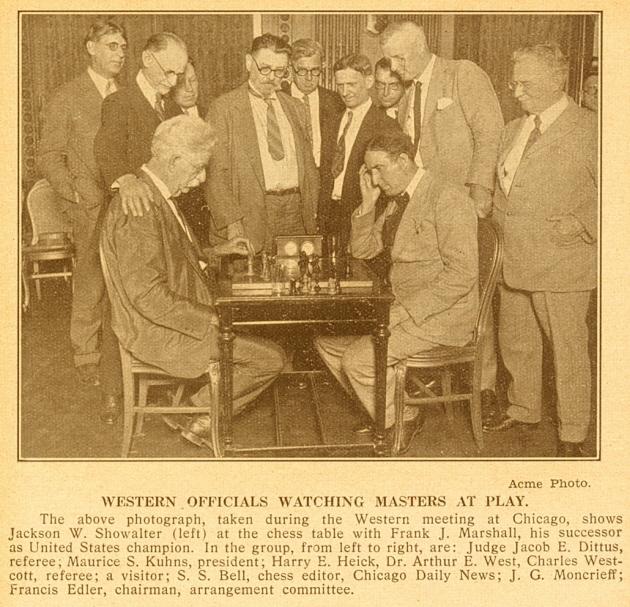
Source: American Chess Bulletin, September-October 1926, page 110
(6972)
John Hilbert submits two items from the Brooklyn Daily Eagle on a baseball match involving many leading chess personalities. The first report appeared on 16 July 1873, page 2:
‘CHESSPLAYERS ON THE BALL FIELD. – A match is on the tapis to be played on the Capitoline field, in which the contestants will be two nines of noted chessplayers. One nine will be captained by Theo. M. Brown, the well-known Brooklyn composer, and the other by the chess champion Captain Mackenzie. The nines, or rather tens, will be as follows:
Mackenzie’s side – Brown’s side
Gilberg – Delmar
H. Muñoz – Perrin
P. Richardson – Mason
Sterl – Dill
Stamper – Dr Barnett
McCutcheon – Monroe
Marache – J. Muñoz
Tomkins – R. Richardson
A. Thompson – E. Muñoz.
The substitutes will include McCutcheon, Carpenter, Chadwick, Horner, Phillips, Worth and Moore. Captain Ferguson, of the Atlantics, will umpire the game, and Mr Chapin will score. The charge for admission will be five dollars to outsiders. If necessary, two days will be occupied in playing the game.’
On 5 August 1873 the Eagle (page 3) returned to the event at some length:
‘THE CHESSPLAYERS’ MATCH. – At the request of several chessplayers who have not seen the humorous account of the baseball contest of Friday week, we give below the full details of the match in question, from Wilkes’s Spirit:
Probably no event in the ball-playing world has created at once more and less interest than did the contest of the chess magnates, which eventuated on Friday, the 25th instant, on the Capitoline Grounds – more interest among the parties directly concerned, and less interest by anyone else. Captain Mackenzie is a fine chessplayer; indeed, it is generally admitted that as a master of the chequered field he has no equal in this country, nor probably in any other. An intelligent, thorough gentleman, he has hosts of admirers. But, as is often the case, he unfortunately seemed to have a weak spot. He imagined that he would make a success on the ball field. He had been over to the Union Grounds and had seen two professional nines perform; and so easy did it seem the way those fellows stopped, batted and threw the ball that he knew he could do it just as well the first time. From that moment he was an uneasy man. Chess no longer had its charms, but ball was on his brain. In a fit of rashness he challenged one Brown to create a nine and oppose the experts he would select. No sooner said than done. In this matter he was largely aided and abetted by one Chadwick, who, with only a superficial knowledge of the game, encouraged the Captain in his mad scheme by various newspaper articles, until all doubts were removed from the champion’s mind. Unknown to the doughty Captain, this Brown was an old ball player – a man of experience on the greensward. Not that he had ever actually played in a real game, but he knew Ferguson by sight, and had often helped to carry the bag of bats on the field, and hallooed “hoorah” and eaten the leather sandwiches peculiar to ball grounds. He selected his nine with a large amount of hindsight and was then prepared to do battle. Before leaving for the grounds a telegram was received from the captain of the Philadelphians, asking if his club would be allowed free admission to the grounds. He said that there were many nice little points his club had failed to pick up as yet, and it would be much easier to learn from the books than to find out by actual play. This request was politely but firmly refused. Upon reaching the grounds we found Mackenzie there, pale but determined, rigged with a pair of No. 14 ball shoes, which some said he had been wearing a week. The whole Richardson family was on hand, Van Wagener, Monroe, Delmar, Mason, the great Dill, Echorn, Tomkins and Brown. Chadwick, satisfied with getting them into this muss, had absented himself. Gilberg and Perrin couldn’t possibly come (they were all on Mackenzie’s side). However, by the assistance of a few outsiders, full nines were formed, and the game proceeded. It was afterward found to be fortunate that these few strangers to our king of games were taken on; otherwise the game would never have come to an end, as they were the only ones who got anyone out. Richardson Sr., having been appointed by the captain (who began to feel his courage oozing out of his finger ends, a little preliminary ball-tossing tending to that effect) as general in chief, upon winning the toss, contrary to usual custom, went to the bat. Mr Burdock of the Atlantics kindly consented to act as umpire upon condition that the captain should post him whenever he failed in a proper interpretation of the rules. Richardson led off with a fine, safe hit away down almost to the short stop, and then Mackenzie proudly toed the plate, and after a few moments of indecision such a belt as he gave the ball, and then he started like a deer for third base, shouting between every jump, “Here I come! Look at me! Oh, just look at me!” We regret to add that before he got around to first he was decided out, as seven or eight of the fielders had surrounded him. And then Dill came to the bat. We have seen hard batters before. Pike of the Baltimores strikes like a streak of lightning. Meyerle bats pretty lively, but it has been reserved till now for us to see a quick hitter. No-one could see the bat move, only a sort of blue haze surrounding the plate, in the centre of which was faintly discerned the form of Dill. It was a matter of regret to his backers that he struck out. Delmar, by a caulker to right, tallied a run.
And then the “weak side” took a turn at it. Brown toed the plate, but wanted time called until the pitcher could be put further back. He said he was too near; he hadn’t time to see the ball. Umpire rebuked him, and called play. He sent a hot daisy cutter down to Delmar, who made as fine a stop as was ever seen on the ball field. It was remarked that the young man didn’t sit down much when riding home in the cars, and it was lovely to see how polite he had suddenly grown; he was willing to surrender his seat instanter to anything which faintly resembled a petticoat. Burdock called him aside and told him that, however successful such stops were, it was a “higher style of art to take the ball with the hands”. To which the young man feebly responded that he “only wished that he had”. Mason clearly demonstrated that he was not so green as he looks (speaking entirely with reference to the game under consideration), by striking out at the ball in a manner which at first blush looked a little wild. But there was method in his madness, and he soon got a beauty for two bases. Brown, who was on third, got excited over his responsible position as captain of this wonderful nine, and ran back to encourage Mason, but was quite disgusted to hear that someone had put him out. No-one ever found out who had attained to this honor; but the umpire said so, and that settled it. Brown was a rainbow as he ambled back to the bench – decidedly blue, assuredly green, and certainly brown. He wanted to argue the matter with Burdock, but was gruffly and properly told to sit down.
Monroe came to the bat with great confidence pictured on his classic phiz. He was equal to the occasion, and soon hit a stinger down toward Richardson. This latter player, seeing that he could not get out of the way of the ball, squared himself for the impending catastrophe. It passed like a flash between his hands, which were about two feet apart, and landed squarely on the second button. The young man staggered around the base for a moment, and then assumed a recumbent position, with an agonized expression on his countenance. The players gathered hastily around, indulging in expressions of genuine sympathy. No signs of life were visible in the sufferer, and the fellows got excited. “Lance his eyes”, said the Captain. “That’s what they did to Hicks when he got hit.” “Rip open his shirt”, shouted Tompkins. No sooner said than done, and tear went his hemstitch, with the 40 cent bosom. This procedure aroused him somewhat, and opening one eye he moaned, “How did that internal mule get on to the grounds? Did he kick anyone else?” They all hastened to assure him that there was no mule around. “Then was there an earthquake?”, sobbed the sufferer. “No, no”, said one and all. “Well”, said he, sitting up, “I never expected to get struck with lightning on a clear day.” Again he was assured that there had been no lightning. Although a photographer by profession, he didn’t seem to want to take a negative. “No mule, no earthquake, no lightning?” “Certainly not”, came from 19 throats. “Well, I swear! If I had known that, I wouldn’t have set down.” And jumping up, was soon as lively as a cricket, putting out in the next inning six men with his own hands, according to his own claim. This cheerful little episode gave a new zest to the players, and the game proceeded as merrily as a marriage bell.
In the second inning Mackenzie was excited. The score stood 1 to 0 in his favor. He wanted to bat every time, and hastily seizing Mason by the heels, whom he, in his perturbed state of mind, imagined to be a bat, he toed the plate. He only relinquished his hold when assured that Mason belonged on the other side. The captain’s “outsiders” got a chance at it this time, and the result was four runs.
And now came the most beautiful part of the game. The weak side went in, and from the word go commenced making magnificent hits for one, two, three and four bases. Around they went – five, six, seven, ten, twelve –would they never stop? It was perfectly impossible to field the balls. Like a flash hare, and then vieing with the hurricane over there. The scorer was demented. Burdock declared that in a life-long experience he had never seen the like. Thirteen, fourteen! Good bye, Captain! – where’s Chad, now? Wouldn’t he enjoy this? It was terrible. The Captain wanted to go home – said that was not the way they played when he saw that game. The spectators were wild. Fifteen! – and then the agony ended. This settled the hash. The game was played out, but in silence. Burdock said it was too much for him, and he retired in favor of Chapin. But volumes would fail to give a proper account of the many beautiful points made during the game. For the “experts”, Mackenzie and Delmar carried off the fielding honors, while Dill reports that he led at the bat. On the other side, Brown maintained that he was entitled to the wreath for good fielding, and the scorer had a difficult task to convince him that, as he had not put anyone out or assisted at it, he couldn’t wear the belt. Mason and Monroe should be crowned, as the former stopped two balls and the latter was all over the field – ubiquitous, in fact; everywhere but on his base. Such life is rarely found in one of his avoirdupois.’
(3044)
In C.N. 3054 John Hilbert drew attention to two further chess/baseball reports, in the Brooklyn Daily Eagle of 16 August and 27 August 1873. They can be read on-line at the following site: http://eagle.brooklynpubliclibrary.org/.
Robert John McCrary (Columbia, SC, USA) writes:
‘The book Baseball in the Garden of Eden (New York, 2011) by the reputable baseball historian John Thorn mentions two major early baseball pioneers who were also important in nineteenth-century chess. One is William R. Wheaton, who was a founding member of the Knickerbocker Baseball Club in 1845, and served as the Club’s first Vice President (see page 37 of Thorn’s book). The Knickerbocker Club has long been credited as a major force in standardizing baseball rules, and thereby starting the game on its path toward becoming the organized “national game” of the United States. Thorn argues that Wheaton played a major role in writing those original Knickerbocker rules, which have been reprinted numerous times in baseball histories. Wheaton is one of six Knickerbocker Club members pictured in a famous daguerreotype dated 1845. On page 36 Thorn calls him “the most important Knickerbocker” in the early weeks of the Club’s existence.
On page 134 Thorn writes:
“The New York game as the national pastime? Chess was more widespread and better organized. The First American Chess Congress of 1857 had included four members from California on its ‘Committee of Cooperation’, including the ever-inventive William R. Wheaton, now of San Francisco.”
This is confirmed on page 57 of the New York, 1857 tournament book.
The other early major baseball pioneer who was also a significant chess figure was Henry Chadwick of Brooklyn. Active in the early decades of organized baseball, Chadwick is considered the “father of baseball”, the originator of many traditional baseball statistics, and a major influence on baseball writing, literature and the evolution of rules and organization. Chadwick was also a chess columnist, writer, and official of some influence. Page 108 of the July 1897 American Chess Magazine reported:
“Henry Chadwick, of baseball and chess fame, gave a simultaneous performance ... winning eight out of 12 games played.”’
(8602)
An article ‘Chess and Baseball’ by Robert John McCrary appeared on pages 53-56 of his publication The Hall-of-Fame History of US Chess (1998). It mentioned, inter alia, ‘Henry Chadwick, “Father of Baseball”, Friend of Chess’, an article by Edward J. Tassinari on pages 47-51 of issue five of Lasker & His Contemporaries (1997). Other sources of information about Chadwick include a book published McFarland & Company, Inc: “The Father of Baseball” A Biography of Henry Chadwick by Andrew J. Schiff.
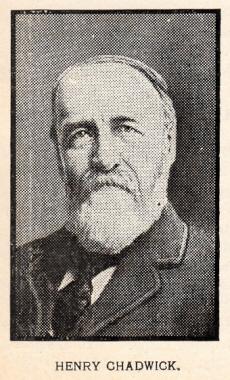
American Chess Bulletin, November 1904, page 123.
Avital Pilpel (Haifa, Israel) writes:
‘As quoted on pages 232-233 of Chess Explorations, Alistair Cooke drew parallels between chess and American football. Baseball too is a game played in turns (pitch by pitch, batter by batter). As in the case of American football, players from both teams often seem to run to positions on the field that bear no relation to the batter or pitcher; it is all part of various well-known strategic plans for either the offensive team (such as “sacrifice fly” and “stealing a base”) or the defensive team (e.g. “intentional walk” and “double play”) which the baseball fan recognizes instantly.
However, baseball, unlike American football, has many strategies which involve the equivalent of a chess sacrifice. Generally, of course, the batter tries to “get on base” by hitting the ball, while the defending team tries to prevent him from doing so. Nonetheless, a batter may “sacrifice” himself, as it is called – intentionally hit the ball in a way that will get him “out” of the game, not reaching the bases – so as to improve the position of another player on his team. Or a pitcher may intentionally allow a batter to advance to a base, judging that the result (for various reasons) would actually lower the batting team’s chances of scoring points.’
(8609)
For further information about Henry Chadwick, see C.N. 8697.
From page 225 of The Rocket That Fell to Earth: Roger Clemens and the Rage for Baseball Immortality by Jeff Pearlman (New York, 2009):
‘For so much of the season, Clemens came off as baseball’s Garry Kasparov – cold, indifferent, unemotional.’
The quote has been forwarded by Tony Bronzin (Newark, DE, USA), who comments:
‘I can conjure a few adjectives to describe Kasparov, but “cold, indifferent, unemotional”?
(8791)
From Robert John McCrary:
‘William R. Wheaton has already been mentioned as a pioneer in the birth of modern baseball, as well as organized chess. He may also be the first documented umpire. On pages 21-22 of A Game of Inches by Peter Morris (Chicago, 2010) the entry on the history of umpires has Wheaton as the first name listed. After briefly referring to the Olympic Ball Club of Philadelphia (which played town ball, a baseball variant, in 1838) the entry reads:
“The Knickerbockers’ rules outlined a similar role for the umpire. William R. Wheaton officiated during a game of 6 October 1845, that appears in the club’s scorebooks.”
It then adds that Wheaton was one of three umpires in a game between the New York Ball Club and the Brooklyn Club on 23 October 1845.’
(9767)
From Emanuel Lasker’s chess column in the New York Evening Post, 2 July 1910, page 6 (although the text was not necessarily by Lasker himself):

To the Chess Notes main page.
To the Archives for other feature articles.
Copyright: Edward Winter. All rights reserved.